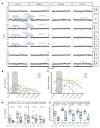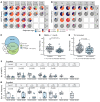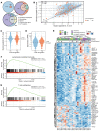Neoantigen-reactive CD8+ T cells affect clinical outcome of adoptive cell therapy with tumor-infiltrating lymphocytes in melanoma
- PMID: 34813506
- PMCID: PMC8759789
- DOI: 10.1172/JCI150535
Neoantigen-reactive CD8+ T cells affect clinical outcome of adoptive cell therapy with tumor-infiltrating lymphocytes in melanoma
Abstract
BACKGROUNDNeoantigen-driven recognition and T cell-mediated killing contribute to tumor clearance following adoptive cell therapy (ACT) with tumor-infiltrating lymphocytes (TILs). Yet how diversity, frequency, and persistence of expanded neoepitope-specific CD8+ T cells derived from TIL infusion products affect patient outcome is not fully determined.METHODSUsing barcoded pMHC multimers, we provide a comprehensive mapping of CD8+ T cells recognizing neoepitopes in TIL infusion products and blood samples from 26 metastatic melanoma patients who received ACT.RESULTSWe identified 106 neoepitopes within TIL infusion products corresponding to 1.8% of all predicted neoepitopes. We observed neoepitope-specific recognition to be virtually devoid in TIL infusion products given to patients with progressive disease outcome. Moreover, we found that the frequency of neoepitope-specific CD8+ T cells in TIL infusion products correlated with increased survival and that neoepitope-specific CD8+ T cells shared with the infusion product in posttreatment blood samples were unique to responders of TIL-ACT. Finally, we found that a transcriptional signature for lymphocyte activity within the tumor microenvironment was associated with a higher frequency of neoepitope-specific CD8+ T cells in the infusion product.CONCLUSIONSThese data support previous case studies of neoepitope-specific CD8+ T cells in melanoma and indicate that successful TIL-ACT is associated with an expansion of neoepitope-specific CD8+ T cells.FUNDINGNEYE Foundation; European Research Council; Lundbeck Foundation Fellowship; Carlsberg Foundation.
Trial registration: ClinicalTrials.gov NCT00937625.
Keywords: Cancer immunotherapy; Immunology; Melanoma; T cells; Therapeutics.
Figures






References
Publication types
MeSH terms
Substances
Associated data
LinkOut - more resources
Full Text Sources
Other Literature Sources
Medical
Molecular Biology Databases
Research Materials

